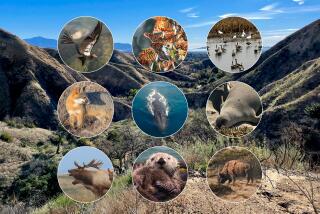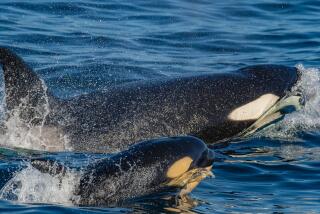Whale-Watching Off Canada With an Irish Air
- Share via
BAY BULLS, Canada — “What do ye want first? A speech or a song?”
Loyola O’Brien, the 28-year-old skipper of the Atlantic Puffin, has left the helm to his first mate and is calling his appealing choices from the wheelhouse door, paying an involuntary tribute to his County Cork forebears with every syllable.
“A song!” comes the answer from a dozen-odd tourists seated in the stern of the Puffin. Skipper O’Brien obliges, a cappella, with a playful tune about his own reliability as a guide:
Ye can search until ye tire,
And never find a bigger liar... The pastel clapboard houses and whitewashed church of Bay Bulls shrink into the distance, the gentle chop of the harbor gives way to the swells of the open sea, and the first mate slips a cassette of Irish reels into the tape deck. Skipper O’Brien grabs a white-haired woman and dances a jig on the afterdeck.
This is whale-watching, Newfoundland-style.
Generations of men have made their living from the sea in the barren province of Newfoundland, seeking cod, lobster, seals, salmon and all manner of whales. The cod fishery may have played a more crucial role in Newfoundland’s hardscrabble economy over the years, but it is the romantic legacy of whaling today that captures the landlubber imagination and draws the tourists. That and such related activities as bird-watching, seal-watching and simply taking in the beauty of sea, sky, cliffs and shoreline.
Today’s enterprising Newfoundland boat-operator knows it’s possible to offer those experiences toappreciative visitors--without ever harming the whale. O’Brien’s Bird Island Charters, which operates the Atlantic Puffin and a one-boat division, Humpback Whale Tours, is just one of more than a dozen boat-tour operators listed by the Newfoundland government as offering whale-watching trips. Still more boat operators offer seal-watching, bird-watching and simply the views off Newfoundland’s forbidding granite coast.
Nature-watching generally is good during late spring, summer and early fall, but whale-watching season hits here in June and July, when the spawning caplin run off the coast and the whales come to feed on the little smelt-like fish. During those two months, O’Brien says, he has had a 95% success rate in finding whales for his clientele. The whales generally turn south for their annual Caribbean winters during the last week of July, and by August they are nearly impossible to find. From then until October--and also in May--O’Brien takes his passengers bird-watching on offshore islands and “jigging” for cod in the traditional Newfoundland way, with a hook and line.
Whatever they do, whether they spot whales or not, vacationers who sample O’Brien’s wares will get a splendid taste of Newfoundland--a remote, fog-shrouded province that is closer, geographically and perhaps spiritually, to Ireland than it is to prairie Canada. Though the Basques first fished and whaled off Newfoundland a century before Columbus set sail, and though the Portuguese and French followed not long after, it is southeastern Ireland to which most Newfoundlanders today trace their ancestry.
Their Celtic heritage has been preserved and magnified down through the generations in Newfoundland’s tiny coastal fishing villages--called outports--which often as not were accessible to the outside world only by boat. Today the province boasts better roads and communication links, but American tourists who make it this far east still tend to fall in love with outport Newfoundland. Aside from the high Arctic, this is about as exotic as Canada gets.
June usually brings sunny, mild weather to Newfoundland, but fog can come in out of nowhere and hang on for days--accounting for O’Brien’s 5% whale-spotting failure rate--and icebergs were floating just off the Atlantic Puffin’s port bow as first-mate Wayne Maloney steered for Gull Island.
Gull Island is an uninhabited spit of rock rising out of the sea off Bay Bulls. When the caplin come through, so do millions of water birds, and they use Gull Island to nest, lay eggs and dive for fish. It is one of the world’s 10 largest sea bird sanctuaries.
“The largest puffin family in eastern North America,” boasts O’Brien, pointing at an estimated 120,000 pairs of the little penguin-like birds, which stand guard over their nests with their white chests puffed out between twin black wings. Sharing the island are thousands of murres and kittiwakes, along with 1.5 million pairs of storm petrels, peeking out from burrows they’ve dug in the ground. The burrowing birds have destroyed the root systems of the island’s trees, and dead branches reach up like ghostly fingers over the nests.
O’Brien spins a bit of bird lore as the passengers peer curiously at the island. Puffins and murres are great divers, he says. His fisherman father used to find puffins tangled in nets he had spread at a depth of 65 feet, and murres are known to dive to 540 feet. As for storm petrels, O’Brien says that in 1974, a biologist working on Gull Island packed two of them aboard a jet, flew them to Australia, released them and waited to see what would happen.
“Two weeks after they were set free, they were back on Gull Island in the same burrows they had been taken from,” he marvels.
Then O’Brien takes a poll: Do people want to continue watching the birds, or would they rather hunt for whales? Everyone wants to see whales, so first-mate Maloney pulls away from Gull Island and the Atlantic Puffin heads out over the proverbial bounding main.
And bound it does. The swells rise bigger and rougher, and the Puffin shoots giddily up the crests and crashes down into the troughs. Saltwater lashes over the deck. A few seasick vacationers huddle miserably in the cabin, heedless of O’Brien’s advice that they’ll perk up if they go outside and fix their gaze on the horizon.
“If ye want to explore nature, you’ve got to take the challenge!” he cries.
Out of nowhere bobs a tiny craft bearing three sodden whale researchers from Memorial University in St. John’s. The sea is too rough for their glorified motorized dinghy, and the Atlantic Puffin slows while the crew rigs up a towline and the scientists climb aboard. As they peel off their insulated wet suits, they announce good news: Whales have been sighted in the area.
O’Brien snaps yet another tape into his tape deck, and we plunge ahead to the incongruous lilt of an Irish jig. We haven’t gone far when a shout goes up: A whale is breaching dead ahead. Now, all queasiness is forgotten as tourists clamber up the swaying ladder to the flying bridge, an elevated platform above the cabin that affords a 360-degree view. All around the Atlantic Puffin, it seems, whales are spouting, breaching and diving.
These are humpbacks, 40-foot whales that sport elegant white side fins and graceful flukes with pearl-gray undersides. They are known for their athletic, spinning breaching style, and for their slow, haunting “song.” Humpbacks are relatively rare as whales go, thanks to what the history books delicately refer to as “the modern whaling industry”: steam-driven craft swift and maneuverable enough to keep pace with the fast-swimming humpbacks, winches strong enough to hoist them dead from up to two miles deep and one-ton cannons that fired harpoons tipped with fragmentation charges.
All that was developed in the second half of the last century, and brought to Newfoundland about 1900. Newfoundland’s humpback population was soon so depleted that Loyola O’Brien’s fisherman father, Joseph (Old Joe) O’Brien, remembers seeing only one or two in an entire lifetime on the water.
Now, tourists have their pick of a seemingly boundless supply. Waving Telephotos wildly with the pitching of the Puffin, they rush from port to starboard and back again as the whales surface first on one side and then the other. O’Brien plays a tape of the humpback “song,” and the eerie hootings and burblings sound out over the water. (The whales beneath us cannot themselves be heard, since the Atlantic Puffin has no sonar equipment; nor can they hear our cassette, although O’Brien claims to know how to whistle to them to make them swim near.)
As the afternoon passes, the sun comes out and turns the sea from gray to azure. The waves ease off, and the boat stops pitching and starts rocking gently. In the clear blue water, the black whales rise obligingly alongside the boat, sometimes singly, sometimes in pairs. They spout, arc out of the water like porpoises, flick their tails and dive under again. It is a hypnotic sight.
Most passengers want to stay out longer, and O’Brien is willing to give an extra half-hour, but one pregnant--and nauseated--passenger says she can’t take any more. Reluctantly, the first mate tacks the boat around. O’Brien snaps off the whale songs and puts the jigs back on. Then he hot-foots it around the deck with the female passengers as the Atlantic Puffin sails back toward Bay Bulls’ quiet harbor.
“This is a trade which will stir the blood of the dullest clod,” wrote Millais back in 1905. That was at the height of the whale slaughter, but his words might just as well describe the innocent charms of an afternoon aboard the Atlantic Puffin.
GUIDEBOOK
Whales Off Newfoundland
The most convenient airport to Bay Bulls, Newfoundland, is in St. John’s, about half an hour away. Bird Island Charters’ and Humpback Whale Tours’ adult fare is about $22 for a 2 1/2-hour trip aboard a 42-foot Cape Island boat. Telephone (709) 753-4850. For an extra $8.50, a van will be sent to pick up nature lovers in hotel lobbies in St. John’s for transport to the Bay Bulls pier.
For more information: Contact Newfoundland Tourism, P.O. Box 8730, St. John’s, Newfoundland, A1B 4K2 Canada, (800) 563-6353.
More to Read
Sign up for The Wild
We’ll help you find the best places to hike, bike and run, as well as the perfect silent spots for meditation and yoga.
You may occasionally receive promotional content from the Los Angeles Times.






